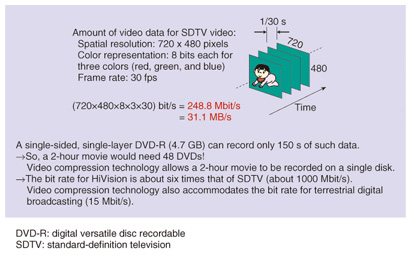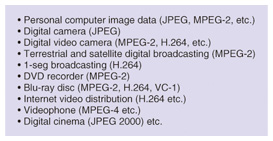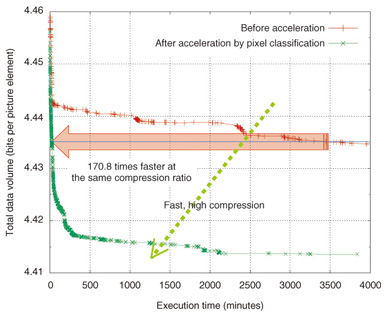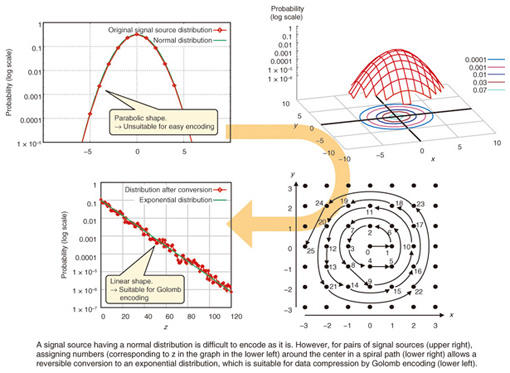 |
|
|
|
|
|
Front-line Researchers Vol. 10, No. 7, pp. 1–5, July 2012. https://doi.org/10.53829/ntr201207fr1 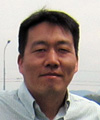 Aim for the "Only One" by Strengthening Advantages Rather Than Overcoming DisadvantagesSeishi Takamura is a Distinguished Technical Member who has approached video encoding research with creative thinking and received remarkable attention from various fields. We asked him to give us an easy-to-understand explanation of video encoding and to give us some insight into the circumstances that give rise to his way of thinking and how he nurtures such thinking. We also asked for some specific suggestions on how to bring ideas to fruition. Evolutionary video encoding is a made-to-order video compression technology for a richer life—Would you tell us something about your current research? What I’m working on now is called evolutionary video encoding. Transmitting digital video data takes a lot of time and accumulating it in personal computers consumes a lot of their capacity because it is so voluminous (Fig. 1). One way around that problem is to compress the data, and my work is to develop video compression technology.
Until now, all types of video have been compressed by the same technology and methods, but what we are working on is the application of compression methods that are appropriate for each particular video. By analogy to clothing, past technologies are like ready-made suits, but what we are aiming for is made-to-measure technology tailored to the video. Examples of current compression technology are JPEG for still images and H.264 for video (Fig. 2). There is also discussion in international standardization activities on HEVC (high efficiency video coding), which aims for double the compression efficiency of H.264. However, each compression technology uses the same algorithm for all types of video.
To achieve even higher compression efficiency, however, we can easily imagine that we should select the compression algorithm best suited for the particular video. For example, the most suitable algorithm differs for video of people and video of scenery. It is impossible to choose the optimal algorithm for each case manually, so we are investigating processing based on a computer algorithm that selects the optimal compression automatically. Moreover, that computer algorithm evolves over time, so we achieved a predictive equation that no human could have produced. We call that evolutionary video encoding. Although evolutionary video encoding attains a higher compression ratio over time, it is currently still too slow for practical use. Now that we have proven that it is possible in principle, our research will focus on shortening the processing time (Fig. 3).
If we can make this technology practical, we will be able to exchange video data rapidly and also be able to store even more video data on a single disc. It will also let us enjoy a more vivid video experience. You do not choose a place to do research. You gain a firm grasp of basic knowledge and past methods and do the work with care and deliberation.—What inspired you to do this research? When I heard a lecture on evolutionary image processing given by Professor Nagao at the Yokohama National University, it made me wonder if that idea could somehow be applied to compression technology. It was about ten years ago. Five years later, a specific plan occurred to me when I was considering research topics and concepts for a freshman researcher. —Was there some aspect of your work that was particularly hard? The pressure is great and that can certainly be hard on the researcher, but I wouldn’t go as far as to call it a hardship. Results and productive research are very important, and the strain involved in continuously producing results is great. We cannot simply give up when things do not go well; all we can do is to have faith in ourselves and press on. Looking back on my research process and experience, it seems that I have mostly been clear-headed in my work. Nevertheless, it seems that there is a lot that I have forgotten. In research, it is not unusual to encounter problems that we cannot handle well even when we try hard to apply different kinds of knowledge. I don’t think that it is appropriate to call that failure. It is important and necessary in research to know how to set milestones. A good track record in setting deadlines is probably important in any line of work. Nevertheless, when I was unable to keep to the milestones, then rather than giving in to perplexity, I chose to clear my mind to think and deal with the problem and move forward. For example, sometimes I come up with a good idea for solving a problem while I’m not in the workplace. About ten years ago, I was struggling with a certain problem and thinking about it from different angles, but could not think of a good solution. Then, one Sunday while I was lying on a beach at the Kamakura seashore near home, a solution flashed into my mind. That idea actually worked, and it led to my receiving the Niwa-Takayanagi Best Paper Award from the Institute of Image Information and Television Engineers. Many researchers probably say this, but even when I am away from my research work, research is not absent from my mind. Looking at it the other way, although there is some work that must be done at the workplace or other particular location, you do not have to be selective about where to conduct experiments in your head. For that, it is only important to be thoroughly familiar with various kinds of basic knowledge and methods. To regard your own field of specialization as simply something to study and understand will not produce good results. I think a good approach is to do careful thought experiments first. Such thought experiments prior to the execution of an idea will fail to provide guidance unless you have various types of knowledge in your mind. Of course, it is also true that most of the time you do not know the outcome until you actually try it. Incidentally, a happy time for me is when doing various thought experiments while I’m in bed at night and ready for sleep. I also like to do programming while riding trains or buses. We should apply our energy to praise and encouragement rather than hardship—So, you think that even hardship is not really a hardship. Could you tell us something of your moments of joy? Four years ago at an image encoding symposium in Japan, I gave the first presentation on evolutionary video encoding—the topic I am working on now. At an informal get-together after the presentation, a number of people who had heard my talk came up to me and made laudatory comments, such as saying that my talk was interesting or gave them a strong impression. I was also delighted to receive the highest award of that symposium for my talk. At the same time, I received encouragement for my idea. There was one thing unrelated to evolutionary video encoding that stimulated their interest greatly. It was the idea of how the difficulty of highly efficient encoding of normally distributed data could be overcome by arranging the data in a two-dimensional lattice and taking values in a spiral shape beginning at the center. Doing that converted a normal distribution, for which highly efficient encoding is possible but difficult, into an exponential distribution, for which efficient encoding is easier (Fig. 4). That idea was praised as beautiful by Professor Bernd Girod, an authority on media coding at Stanford University, and others. It also led to a Yamashita Memorial Research Award from the Information Processing Society of Japan.
I’ve also heard the words, “This is great.” many times coming out of nowhere. While I am very happy to receive praise directly in this way, when I hear of a good evaluation second-hand, from an unexpected source, it is truly pleasant and encouraging. —My impression is that you find joy rather than worry to be more of a stimulation in life. From your experience, what advice do you have for the young researchers. I believe that young researchers pass their days being too busy. When one thinks about it later, the younger you are, the more time you have to spend for your research. For example, I am now often away from home on business, either in Japan or abroad, so on days off I spend my time going out with my family and enjoying being with them. Also, to be with my three children while they are small, I usually leave work at 6:30 pm. Even if I’m not able to have dinner with them, I still put priority on time shared with them in other ways. Looking at this as a common thing, I think that you have more time to spend for pursuing your own research when you are in your youth. Although I, too, may fail to recognize when there is time to use for research, I will try to describe my ideas of how to be a researcher.
I will use these tips as the basis for my own ongoing endeavor to master encoding research. I would like to continue to help more young people enter the world of research and develop into mature researchers. Leadership is not one of my strengths, but I believe that helping and showing how I, as a researcher, grapple with my own research is something that I can do. Seishi TakamuraDistinguished Technical Member, Senior Research Engineer, Supervisor in the Video Coding Group of NTT Media Intelligence Laboratories. He received the B.E., M.E., and Ph.D. degrees from the Department of Electronic Engineering, Faculty of Engineering, the University of Tokyo in 1991, 1993, and 1996, respectively. His current research interests include efficient video coding and ultrahigh quality video coding. He has fulfilled various duties towards the research and academic community in current and prior roles such as: Associate Editor of IEEE Transactions on Circuits and Systems for Video Technology, Technical Program Committee Chair of the IEEE Tokyo Section, the Institute of Electronics, Information and Communication Engineers (IEICE) Image Engineering SIG Secretary and Director––Technical Relations of the Institute of Image Information and Television Engineers (ITE). From 2005 to 2006, he was a visiting scientist at Stanford University, California. He has received 21 academic awards including the ITE Niwa-Takayanagi Best Paper Award in 2002, Information Processing Society of Japan (IPSJ) Nagao Special Researcher Award in 2006, and PCSJ Frontier Awards in 2004 and 2008. He is a senior member of IEEE and IEICE and a member of MENSA, IPSJ, the Institute of Image Electron-ics Engineers of Japan, and ITE. |

